End-point RT-PCR based on a conservation landscape for SARS-COV-2 detection
- PMID: 35306521
- PMCID: PMC8933765
- DOI: 10.1038/s41598-022-07756-6
End-point RT-PCR based on a conservation landscape for SARS-COV-2 detection
Abstract
End-point RT-PCR is a suitable alternative diagnostic technique since it is cheaper than RT-qPCR tests and can be implemented on a massive scale in low- and middle-income countries. In this work, a bioinformatic approach to guide the design of PCR primers was developed, and an alternative diagnostic test based on end-point PCR was designed. End-point PCR primers were designed through conservation analysis based on kmer frequency in SARS-CoV-2 and human respiratory pathogen genomes. Highly conserved regions were identified for primer design, and the resulting PCR primers were used to amplify 871 nasopharyngeal human samples with a previous RT-qPCR based SARS-CoV-2 diagnosis. The diagnostic test showed high accuracy in identifying SARS-CoV-2-positive samples including B.1.1.7, P.1, B.1.427/B.1.429 and B.1.617.2/ AY samples with a detection limit of 7.2 viral copies/µL. In addition, this test could discern SARS-CoV-2 infection from other viral infections with COVID-19-like symptomatology. The designed end-point PCR diagnostic test to detect SARS-CoV-2 is a suitable alternative to RT-qPCR. Since the proposed bioinformatic approach can be easily applied in thousands of viral genomes and over highly divergent strains, it can be used as a PCR design tool as new SARS-CoV-2 variants emerge. Therefore, this end-point PCR test could be employed in epidemiological surveillance to detect new SARS-CoV-2 variants as they emerge and propagate.
© 2022. The Author(s).
Conflict of interest statement
The authors declare no competing interests.
Figures





References
-
- World Health Organization. https://covid19.who.int/ (2021).
Publication types
MeSH terms
Substances
Supplementary concepts
LinkOut - more resources
Full Text Sources
Medical
Miscellaneous

